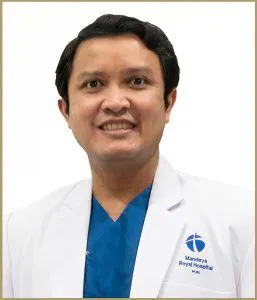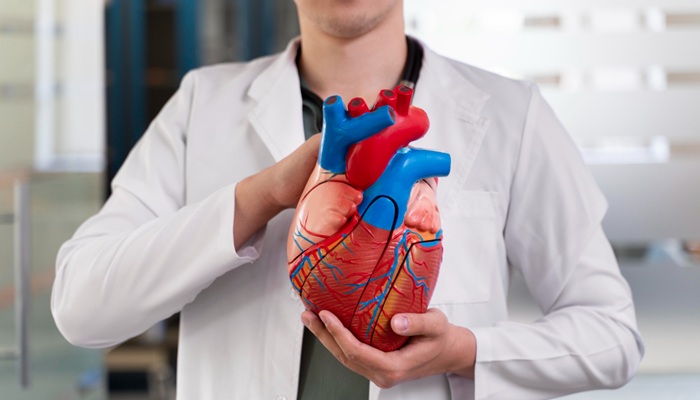The aorta is the largest artery in the body, responsible for carrying blood and oxygen from the heart to the rest of the body. It is shaped like a curved candy cane. The ascending aorta carries blood upward from the heart, while the descending aorta flows downward toward the abdominal area.
An aneurysm can occur in any artery. An aortic aneurysm happens when a portion of the aorta’s wall weakens. The blood pressure flowing through the artery can cause this weakened section to balloon outward—this bulge is what’s known as an aortic aneurysm.
Contents
Types of Aortic Aneurysms
There are two main types of aortic aneurysms affecting different areas of the body:
- Abdominal Aortic Aneurysm (AAA): This occurs in the “handle” portion of the aorta that extends downward.
- Thoracic Aortic Aneurysm (TAA): Also known as a heart aneurysm, this occurs in the arch-like portion at the top of the aorta. In patients with Marfan syndrome (a connective tissue disorder), TAA can develop in the ascending aorta.
Symptoms of Aortic Aneurysm
In many cases, people are unaware they have an aortic aneurysm, as it often causes no symptoms until it ruptures.
A ruptured aneurysm is a medical emergency requiring immediate treatment. Call emergency services right away if you or someone nearby experiences a ruptured aneurysm.
Common symptoms of a ruptured aneurysm may appear suddenly and can include:
- Dizziness or lightheadedness.
- Rapid heartbeat.
- Sudden, severe chest pain, abdominal pain, or back pain.
Detecting an aortic aneurysm before it ruptures offers the best chance of recovery. As the aneurysm grows, symptoms may begin to appear, such as:
- Shortness of breath or difficulty breathing.
- Feeling full quickly even after eating small amounts.
- Pain in the area where the aneurysm develops (neck, back, chest, or abdomen).
- Painful or difficult swallowing.
- Swelling in the arms, neck, or face.
Causes of Aortic Aneurysm
The exact cause is often unknown but may include:
- Atherosclerosis (narrowing of the arteries).
- Inflammation of the arteries.
- Genetic conditions affecting connective tissue (such as Marfan syndrome or Ehlers-Danlos syndrome).
- Injury to the aorta.
- Infections, such as syphilis.
Risk Factors for Aortic Aneurysm
Family history and lifestyle factors can increase the risk. The condition is most common among people who:
- Smoke.
- Are over 65 years old.
- Are male.
- Have a family history of aortic aneurysm.
- Have high blood pressure (hypertension).
Complications of Aortic Aneurysm
A ruptured aneurysm causes internal bleeding. Depending on its location, rupture can be life-threatening. With prompt treatment, many patients can recover from a ruptured aneurysm.
A growing aortic aneurysm can also lead to a tear (aortic dissection) in the arterial wall. Dissection allows blood to leak between the wall’s layers, narrowing the artery and restricting blood flow from the heart to the rest of the body. The buildup of pressure in the arterial wall can further increase the risk of rupture.
Diagnosing an Aortic Aneurysm
Many aneurysms develop without symptoms and are discovered during routine check-ups or health screenings.
If you are at high risk or show symptoms of an aortic aneurysm, your doctor may recommend imaging tests to detect and diagnose the condition, such as:
- CT scan.
- CT or MRI angiography.
- Ultrasound.
Treatment for Aortic Aneurysm
If an aortic aneurysm has not ruptured, your doctor will closely monitor the condition. For patients with risk factors, regular screenings may also be advised.
The goal of treatment is to prevent the aneurysm from growing large enough to tear or rupture the artery. For small, unruptured aneurysms, medication may be prescribed to improve blood flow, lower blood pressure, or control cholesterol levels. These measures can slow aneurysm growth and reduce pressure on the arterial wall.
Surgical Options for Aortic Aneurysm
Large aneurysms with a high risk of rupture may require surgery. Treatment options include:
- Open Aneurysm Repair: The aneurysm is surgically removed and replaced with a graft (a special tube) to repair the artery. This procedure can also be performed in cases of rupture.
- Endovascular Aneurysm Repair (EVAR): A minimally invasive procedure using a catheter (thin tube) to place a graft inside the artery to strengthen or repair it. Variants include Thoracic Endovascular Aneurysm Repair (TEVAR) and Fenestrated Endovascular Aneurysm Repair (FEVAR).
Bentall Procedure at Mandaya Royal Hospital Puri
Mandaya Royal Hospital Puri offers the Bentall procedure, which replaces the damaged portion of the aorta and heart valve caused by an aortic aneurysm with a durable implant. This procedure restores normal blood flow and prevents aortic rupture.

The hospital is home to dr. Bagus Herlambang, Sp.BTKV (K), Ph.D, a consultant cardiovascular and thoracic surgeon experienced in performing the Bentall procedure for both aortic aneurysm and aortic dissection.
dr. Bagus’ expertise includes:
- Coronary Artery Bypass Graft (CABG)
- Cardiac Valve Repair/Replacement
- Myxoma Tumor Removal
- Atrial/Ventricular Septal Defect (ASD/VSD) repair
Clinic hours at Mandaya Royal Hospital Puri:
- Tuesday: 17.00 – 19.00 WIB
- Wednesday: 18.00 – 19.30 WIB
- Thursday: 18.00 – 19.30 WIB
If you would like to consult Dr. Herlambang regarding an aortic aneurysm or Bentall procedure, visit Mandaya Royal Hospital Puri.
For a more convenient experience, use the WhatsApp Chat, Book Appointment feature, or the Care Dokter app available on Google Play and App Store to check queue numbers, schedule visits, and access complete information.



